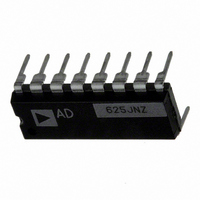AD625JNZ Analog Devices Inc, AD625JNZ Datasheet - Page 14

AD625JNZ
Manufacturer Part Number
AD625JNZ
Description
IC AMP INST 25MHZ LN 16DIP
Manufacturer
Analog Devices Inc
Type
Low Noiser
Specifications of AD625JNZ
Amplifier Type
Instrumentation
Number Of Circuits
1
Slew Rate
5 V/µs
Gain Bandwidth Product
25MHz
-3db Bandwidth
650kHz
Current - Input Bias
30nA
Voltage - Input Offset
50µV
Current - Supply
3.5mA
Voltage - Supply, Single/dual (±)
±6 V ~ 18 V
Operating Temperature
0°C ~ 70°C
Mounting Type
Through Hole
Package / Case
16-DIP (0.300", 7.62mm)
Bandwidth
650 kHz
Common Mode Rejection Ratio
75
Current, Input Bias
±30 nA
Current, Input Offset
±2 nA
Current, Output
5 mA
Current, Supply
3.5 mA
Number Of Amplifiers
Five
Package Type
PDIP-16
Power Dissipation
450 mW
Resistance, Input
1 Gigaohms
Temperature, Operating, Range
0 to +70 °C
Voltage, Input Offset
50 μV
Voltage, Noise
4 nV/sqrt Hz
Voltage, Output Swing
±10 V
Voltage, Supply
±6 to ±18 V
No. Of Amplifiers
5
Input Offset Voltage
200µV
Gain Db Min
1dB
Amplifier Output
Single Ended
Cmrr
115dB
Supply Voltage Range
± 6V To ± 18V
Rohs Compliant
Yes
Lead Free Status / RoHS Status
Lead free / RoHS Compliant
Output Type
-
Current - Output / Channel
-
Lead Free Status / Rohs Status
RoHS Compliant part
Electrostatic Device
Available stocks
Company
Part Number
Manufacturer
Quantity
Price
AD625
DETERMINING SPGA RESISTOR NETWORK VALUES
The individual resistors in the gain network can be calculated
sequentially using the formula given below. The equation deter-
mines the resistors as labeled in Figure 41. The feedback resis-
tors and the gain setting resistors are interactive, therefore; the
formula must be a series where the present term is dependent on
the preceding term(s). The formula
can be used to calculate the necessary feedback resistors for any
set of gains. This formula yields a network with a total resistance
of 40 kΩ. A dummy variable (j) serves as a counter to keep a
running total of the preceding feedback resistors. To illustrate
how the formula can be applied, an example similar to the
calculation used for the resistor network in Figure 38 is exam-
ined below.
1) Unity gain is treated as a separate case. It is implemented
2) Before making any calculations it is advised to draw a resistor
with separate 20 kΩ feedback resistors as shown in Figure 41.
It is then ignored in further calculations.
network similar to the network in Figure 41. The network
will have (2 × M) + 1 resistors, where M = number of gains.
For Figure 38 M = 3 (4, 16, 64), therefore, the resistor string
will have seven resistors (plus the two 20 kΩ “side” resistors
for unity gain).
1000
800
400
200
100
R
80
40
20
10
8
4
2
1
F i
1
+
1
=
(
20
4
k
Ω
–
16
∑
j
1
=
0
R
R
ON
F j
GAIN
64
= 500
) ( –
1
R
ON
G
R
256
G
ON
= 1k
i
=
i
1
= 0
)
R
ON
1024
G
R
= 200
0
F
0
=
=
1
4096
0
3) Begin all calculations with G
4) The center resistor (R
5) If different resistor values are desired, all the resistors in the
6) Round off errors can be cumulative, therefore, it is advised to
TO GAIN SENSE
R
R
mined last. Its value is the remaining resistance of the 40 kΩ
string, and can be calculated with the equation:
network can be scaled by some convenient factor. However,
raising the impedance will increase the RTO errors, lowering
the total network resistance below 20 kΩ can result in ampli-
fier instability. More information on this phenomenon is
given in the RPGA section of the data sheet. The scale factor
will not affect the unity gain feedback resistors. The resistor
network in Figure 38 has a scaling factor of 650/625 = 1.04,
if this factor is used on R
tor values will match exactly.
carry as many significant digits as possible until all the values
have been calculated.
R
(PIN 2)
F 1
F 2
F 3
CONNECT IF UNITY
GAIN IS DESIRED
= (20 kΩ – R
= [20 kΩ – (R
= [20 kΩ – (R
R
R
20k
F 0
F 0
R
+ R
+ R
AD75xx
G
TO GAIN DRIVE
= 40 k Ω – 2 (R
(PIN 5)
F 1
F 1
= 15 kΩ ∴ R
+ R
RF
RF
R
40 k Ω – 39.375 k Ω = 625 Ω
F 0
F 0
1
G
2
F 0
) (1–1/4): R
+ R
F 2
=
+ R
G
(
= 18.75 kΩ ∴ R
of the highest gain setting), is deter-
40
RF
F 1
F 1
F 1
N
)] (1–4/16):
, R
k
+ R
F 0
RF
0
Ω
F 2
G
F 2
= 1 and R
+ R
F 0
–
F 2
= 3.75 kΩ
, R
RF
2
)] (1–16/64):
= 0 ∴ R
N
F 1
∑
j
F 3
M
=
, and R
0
+ R
R
TO GAIN DRIVE
F j
F 3
F 0
RF
F 2
(PIN 12)
)
F 1
2
= 937.5 Ω
= 0.
+ R
G
CONNECT IF UNITY
= 15 kΩ
GAIN IS DESIRED
, then the resis-
F 3
)
20k
TO GAIN SENSE
(PIN 15)








